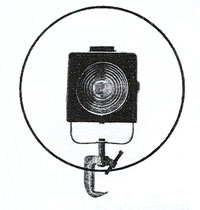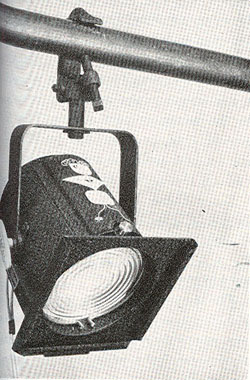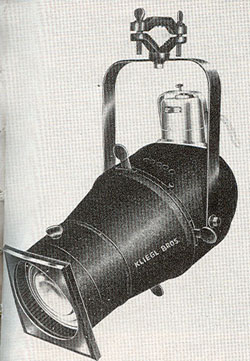

BY TOM SKELTON
courtesy of
Dance Magazine
first published
May 1956
TOOLS OF LIGHTING DESIGN: HOW TO SPEND $265 WISELY
It is my impression that when a new theatre is being built, the architect works very carefully to plan every detail of the beautiful lobby and the comfortable seats, but when he gets to the stage, and the budget is already used up, he is at rather a loss to decide how to allot the few remaining pennies. First to be different, on the theory that these elements can be added later, are the lighting equipment, the dressing rooms, a good stage floor and a good set of draperies – if indeed they had been included in the original plans at all.
If anything is to be added later, it might be a set of borderlights and footlights. This probably represents an investment of $2,000 or $3,000, and is practically useless for modern lighting purposes. The same amount of money could have been spent on spotlights and a dimmerboard to produce a fine and flexible lighting set-up capable of meeting almost all demands.
Dance teachers often ask what is the most essential equipment to buy with the first hundred dollars. (Many civic organizations that use the auditorium are anxious and willing to contribute some equipment, and they often refer to the dance teacher as an authority whose experience they respect.) assuming that you, as a dance teacher, are working on a limited budget, here is a plan for the first $265 worth of basic equipment.
The very first $15 should go for improvised equipment – which will still be useful as you gradually accumulate better equipment. For your money you will get four R-40 and four swivel sockets with a screw base, or PAR 38 Reflector Lamps, spot focus, 150 watts (about $1.50 each). You can find all of these in a big hardware store. Then, if you remove the shade from an ordinary bridge lamp and replace the light bulb with this socket and lamp, you’ll have a spotlight standard for the wings of the stage!
Your chief problem will be to resist sales talk when you buy these items, because you will be encouraged to buy a color holder (for about $1.50) which attaches too the front of the bulb to hold a glass color medium ($1.05) and all sorts of clamp units (ranging from $3 to $10) to screw the lamp into and attach to something. The “something” you are supposed to attach it to does not exist when you get to the theatre, so you’ll end up borrowing somebody’s bridge lamp anyway! You may also be encouraged to by a $5 “barn door” attachment to mask the spill from the lamp. While all of these devices are good and useful for their purposes, at best the lighting you will get from Reflector Lamps is less than satisfactory and the same amount of money would buy a Fresnel, which is designed exclusively for stage lighting, and can serve you much better.

A 6” Fresnelite
You’ll find that the R-40 Reflector Lamps come in colors – I would suggest that you get steel blue and two lavenders – so that eliminates the need for the color holder and glass color medium. A simple swivel socket of some sort (for under $2) o a gooseneck will permit you to aim it to the stage, and this eliminates any clamp units. For masking the spill of the lamp so that it doesn’t go all over the draperies and distract from the dancer you can use ordinary kitchen aluminum foil which is safe and which will easily press around the lamp in any shape you want. Spray the inside of the foil with flat black paint so that the foil itself will not reflect light onto the curtains.

A 6” Klieglite
On the other hand, I have seen many auditoriums where someone has invested hundreds of dollars in Reflector Lamps “with accessories” and mounted them in the borderlights, footlights and wings, always wishing they had a few more to fill in the dark spots. They have, unfortunately, lost sight of the fact that while improvised equipment may be less expensive, you have to have so much more of it to equal the effect of professional equipment that the saving is gone. Reflector Lamps, which are designed primarily for display work, are most useful on the stage whey they are used to fill dead spots or for special effects. I recommend buying them first only because I presume that as soon as you have more money, you will invest it in practical equipment that will relegate the Reflector Lamps to their proper place.
The four Reflector Lamps can be placed at the four corners of the stage, focused straight across, so that they provide beams of light to contrast with the general illumination that comes from the footlights and borderlights.
Start to establish your lighting by turning all of your foots and borders on. If dimmers are available, by dimming the reds and whites down to about half, you’ll have flattering lavender that is not too bright or harsh. If no dimmers are available, you can either change the white bulbs for bulbs of very small wattage, or unscrew most of the bulbs until you arrive at a pleasing lavender wash.
Your next acquisition should be professional lighting equipment. There are two types of modern spotlights that, for general purposes, prove to be the most practical: 1) The ellipsoidal reflector (called Lekolite or Klieglite, depending on the manufacturer) which produces a sharp even beam of intense light, is the best spotlight for front lighting since it can be masked with built-in shutters so that it will not spill on the proscenium wall or on the audience’s head, and because it is designed with a system of reflectors and lenses so that it can be mounted 30 or more feet from the stage on the ceiling or walls over the audience’s head or on the front of the balcony. The 6” or 8” lens type uses a 500 or 750-watt lamp, and ranges in rice from $45 to $60 depending on the accessories and the lenses; 2) The spotlight with the Fresnel lens (commonly called a Fresnel) produces a soft-edged beam of light with a practical throw of 15 to 25 feet, and is therefore generally used on stage, either mounted on pipes overhead or on stands in the wings or tormentors. The 500-watt Fresnel ranges from $16 to $22, depending on how well the unit is manufactured, and on the accessories that come with it.
Since these prices do not include the lamps (light bulb), connectors (plugs) or cable (extension cord) count on from $7 to $12 more to have each spotlight in working order.
The next money you spend should be $50 for two 500-watt Fresnels that you can put either on standards in the ends of the first light pipe, so that they focus diagonally across the stage. The spotlights come with clamps, and a local plumber should be able to devise some sort of pipe, mounted in a heavy base, that will serve as a standard. Your electrician should use #14 (15 amp) cable and standard 15 amp pin connectors or twist-lock connectors.
There are several advantages if you mount the Fresnels on standards where they can be reached to change focus and gelatine colors, during the performance, by slowly lowering a piece of cardboard in front of the spotlight to achieve the effect of having the spotlight dim out; 3) The angle is flatteringly form giving; and 4) one spotlight can cover two-thirds of the stage.
With the Fresnels in the downstage entrances (or #I wings), the 4 Reflector Lamps can be moved to the #II and #III wings Right and Left, which gives us a right wash in steel blue (made up of 1 steel blue Fresnel and 2 steel blue Reflector Lamps) and a left wash in lavender. Overhead and front lighting are still provided by the foots and borders.
Until you have a dimmerboard that will control all of the lighting equipment, it is wise to run the cable from all of the spotlights and Reflector Lamps to one place backstage so that one person can control them all by plugging and unplugging.
Next in importance in your purchases is $100 for two Lekolites or Kleiglites to be mounted over the audience’s head, one focused to cover the right half of the stage and the other the left half. Their cables also should be run to the same central place backstage. These front lights, of course, cannot be reached for gel or focus changes, nor can they “dimmed in” with the cardboard device, so it is generally wiser to turn them on before the houselights go out and leave them on throughout the entire ballet, which the audience cannot help but notice, choose a color for them, like special lavender, that will be appropriate for all of the program.
The next $100 will provide four more Fresnels. Two of them can replace the Reflector Lamps in the #II wings and to of them can be hung near the center of the 1st light pipe with the focus angled so that the Fresnel that is mounted on the Right hits the left half of the stage, and the Fresnel that is mounted on the Left hits the right half of the stage. The Reflector Lamps are now relegated to their proper relative importance, for two of them are in #II wings to fill in the area that the Fresnels miss, and the other two are free to be used a special effects; i.e., they are placed in the footlights, on the floor in the wings, or they can be mounted overhead and focused straight down to make a puddle of light any place on the stage or to make a center path or a center area. Or, by changing to a more theatrical color, they can represent something special from the wings, such as fire or the first rays of the sun, or the doorway to the house of the devil, etc.
Of the “12 basic dance areas” described in the December issue of DANCE Magazine, this $265 worth of equipment will cover them all, and surely $265 should not be too difficult to raise in a benefit performance sponsored by the dance teachers, the PTA and the various clubs who use the local auditorium.
Next month the dimmerboard will be discussed, and we’ll come back to the subject of improvised equipment.
THE END